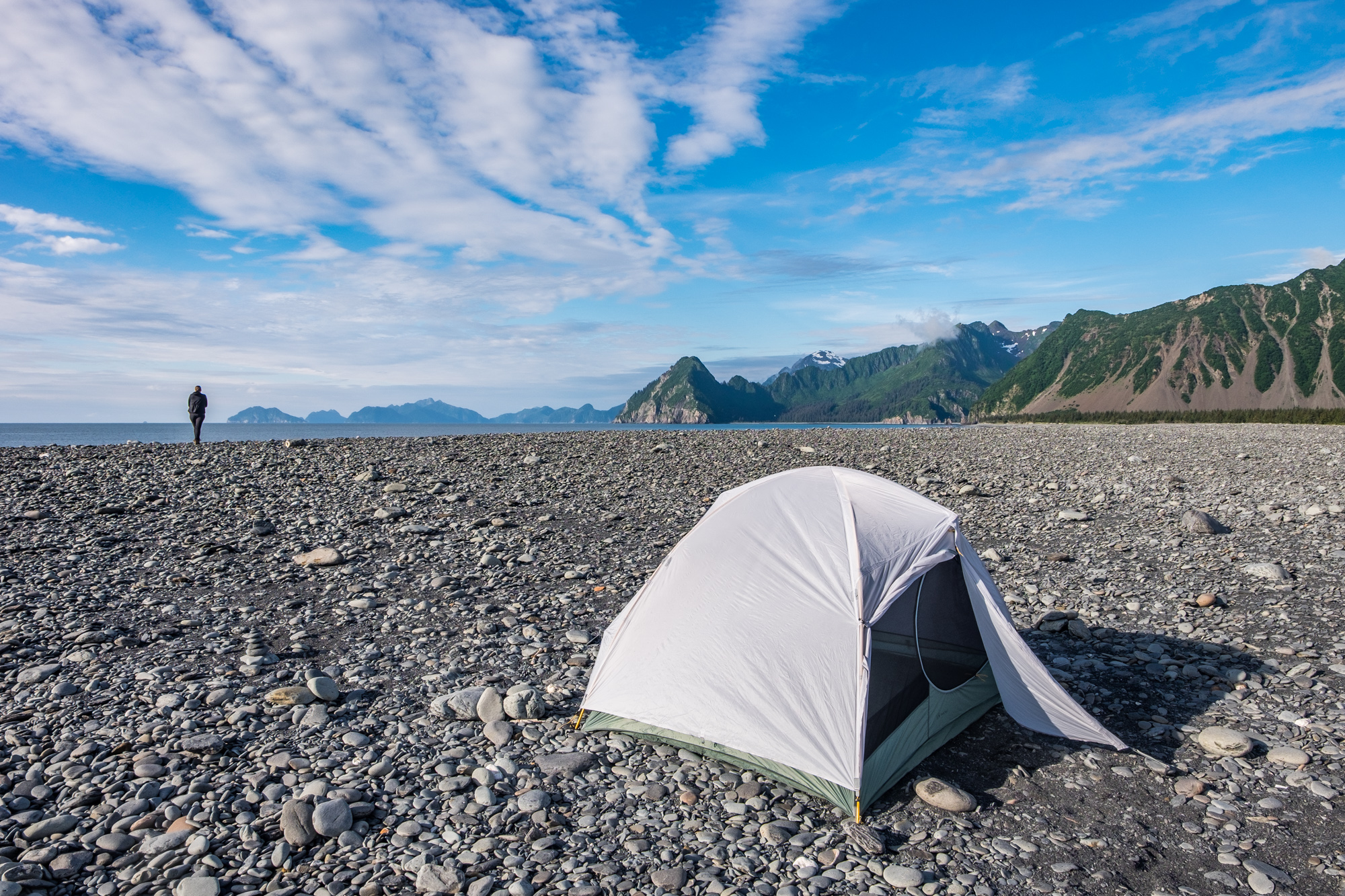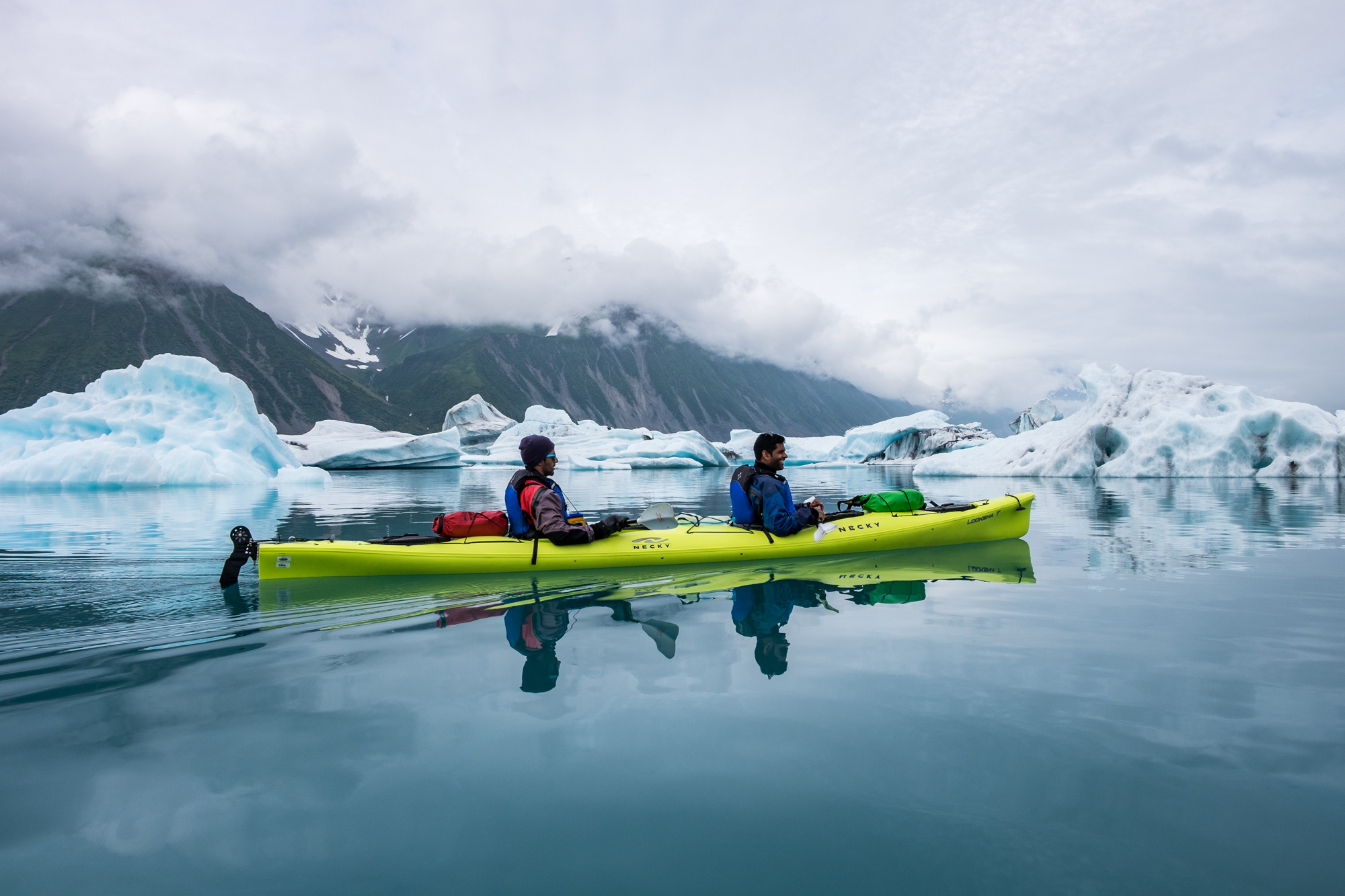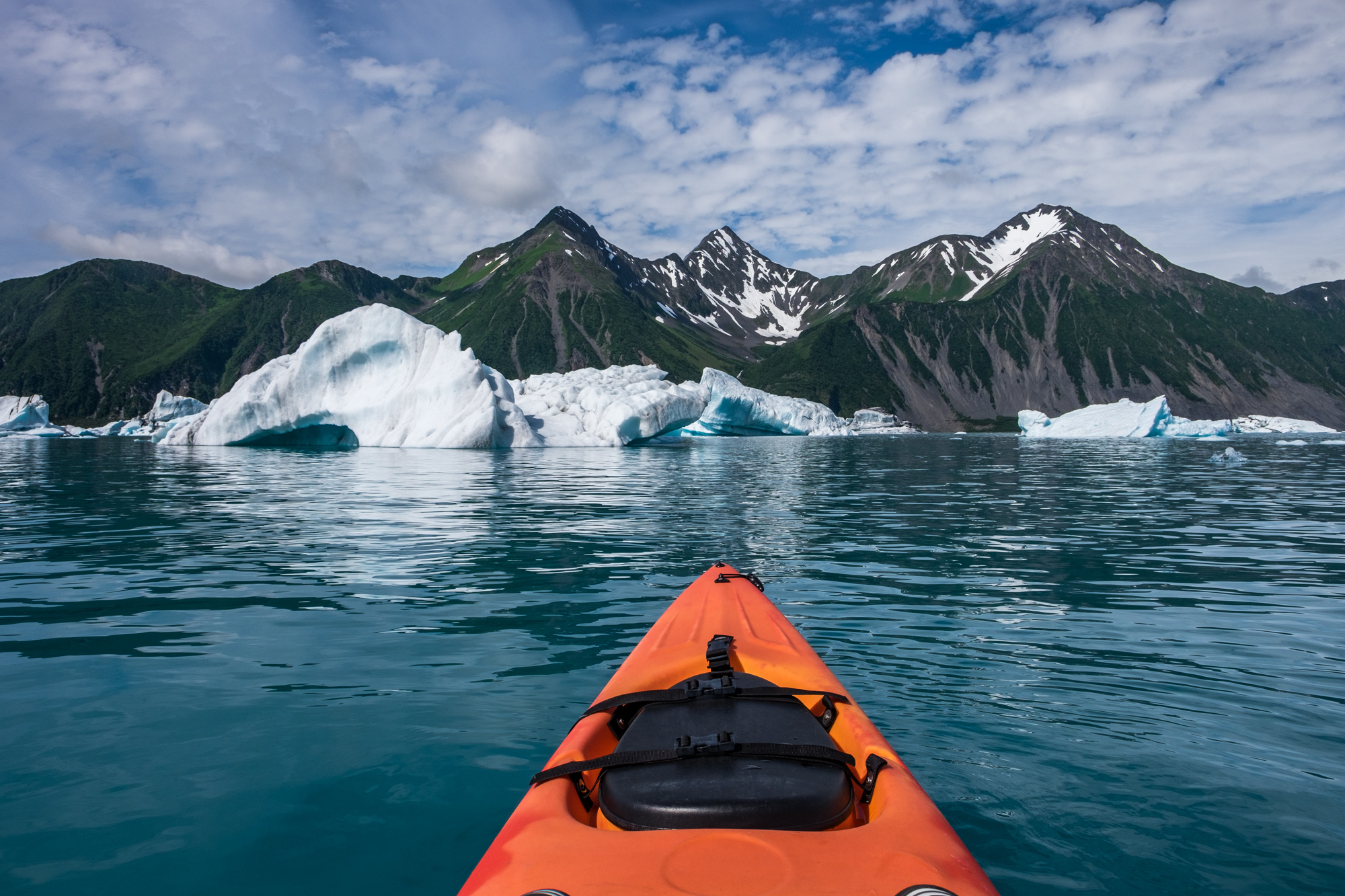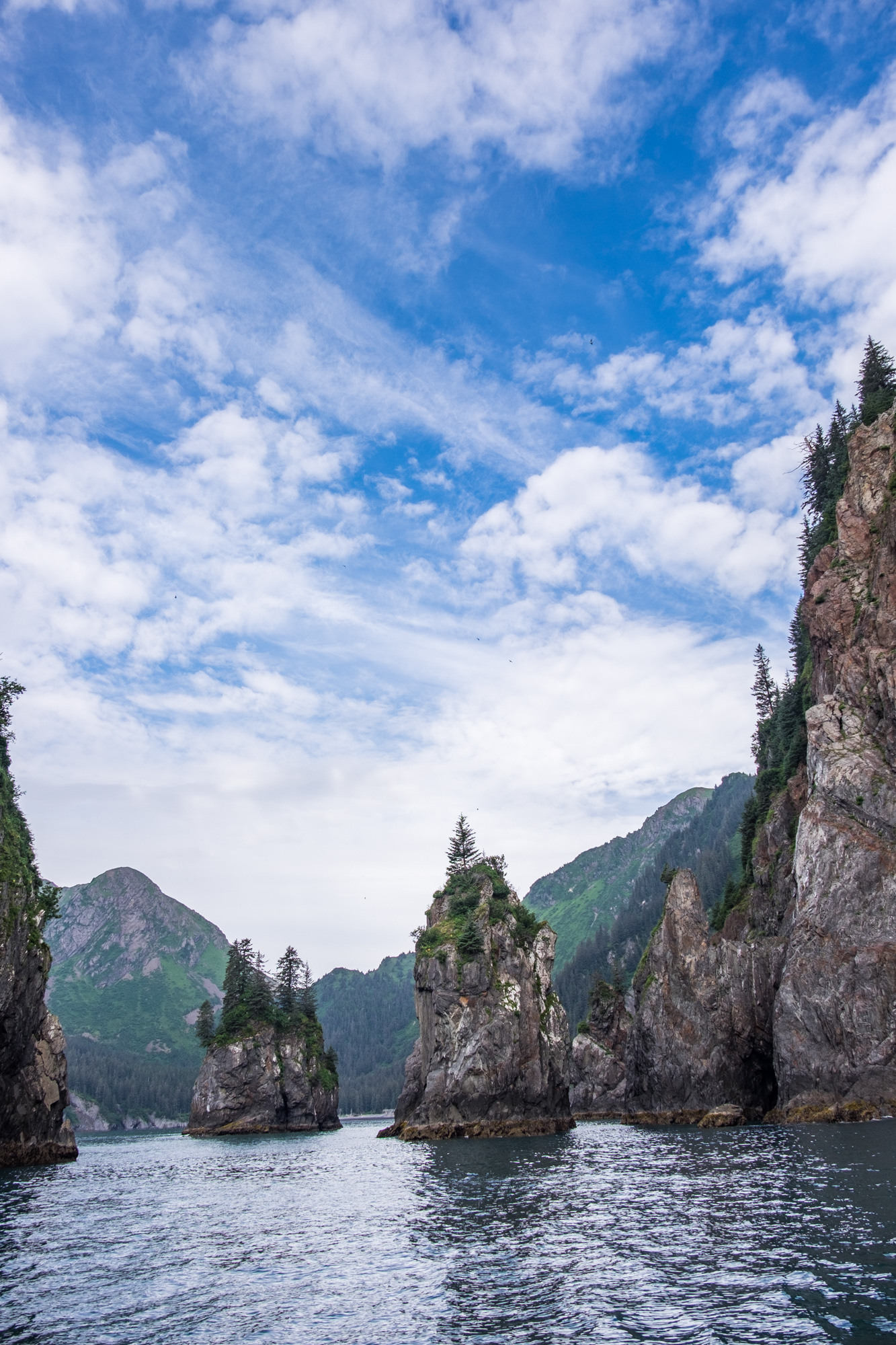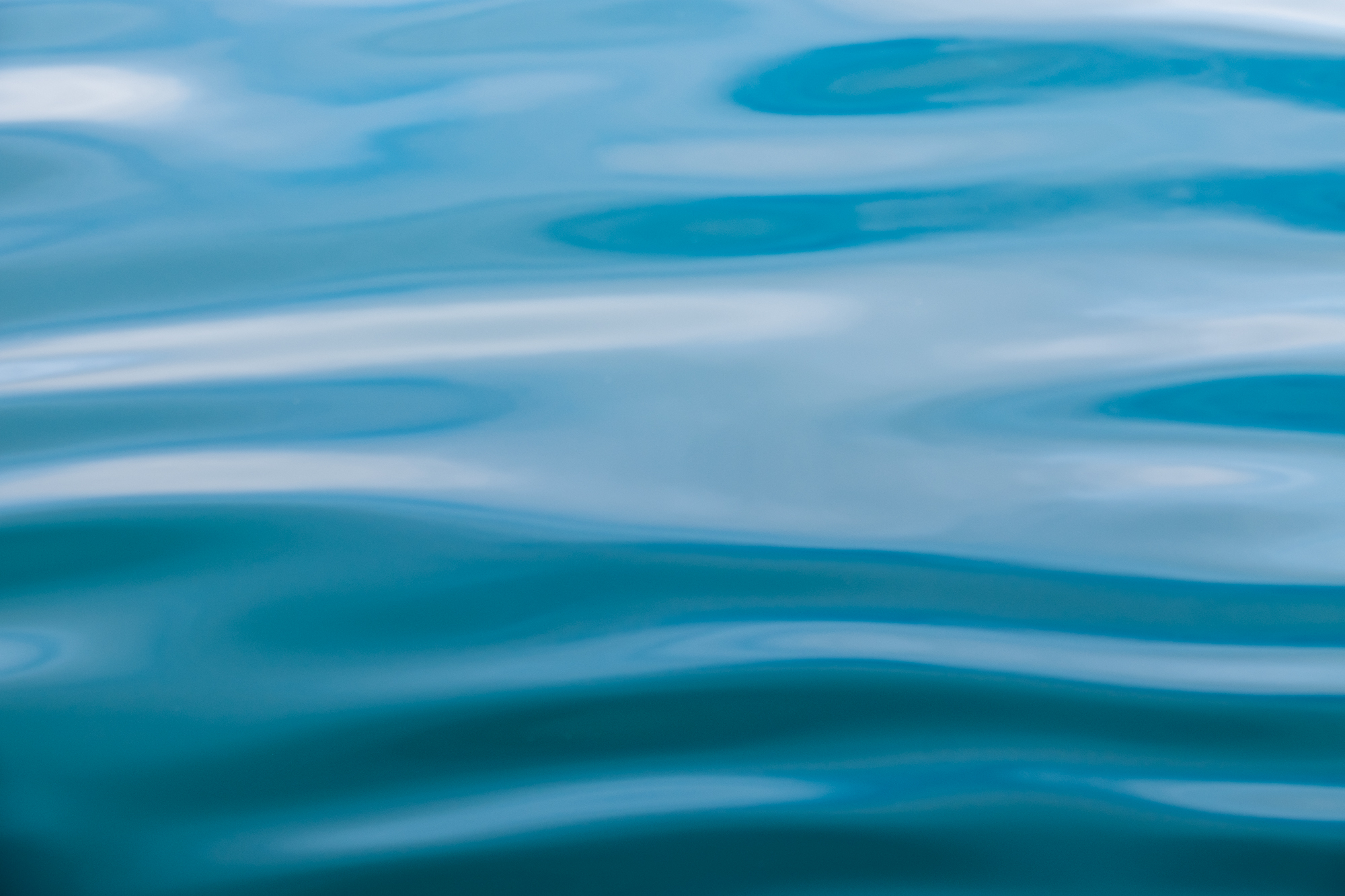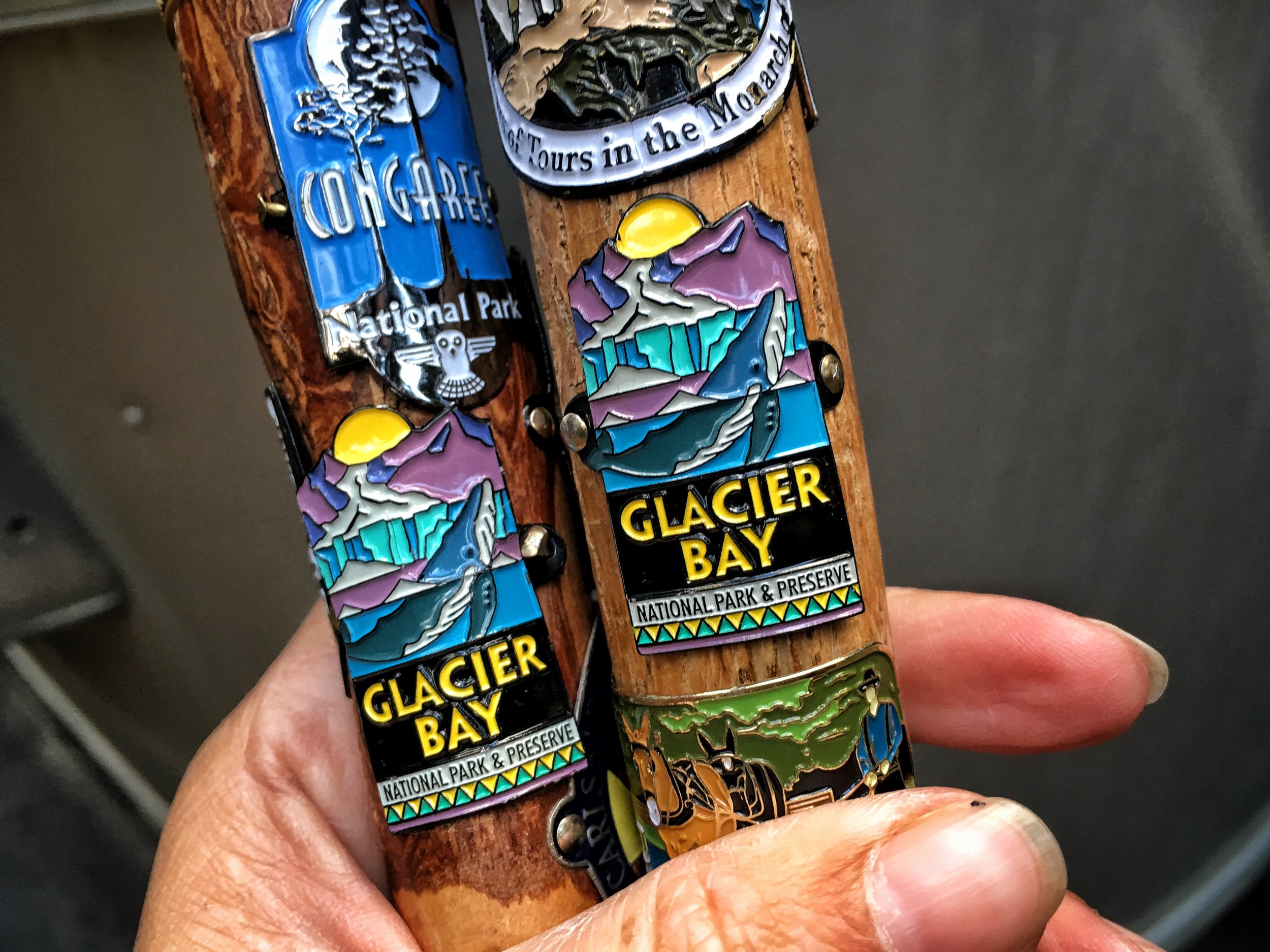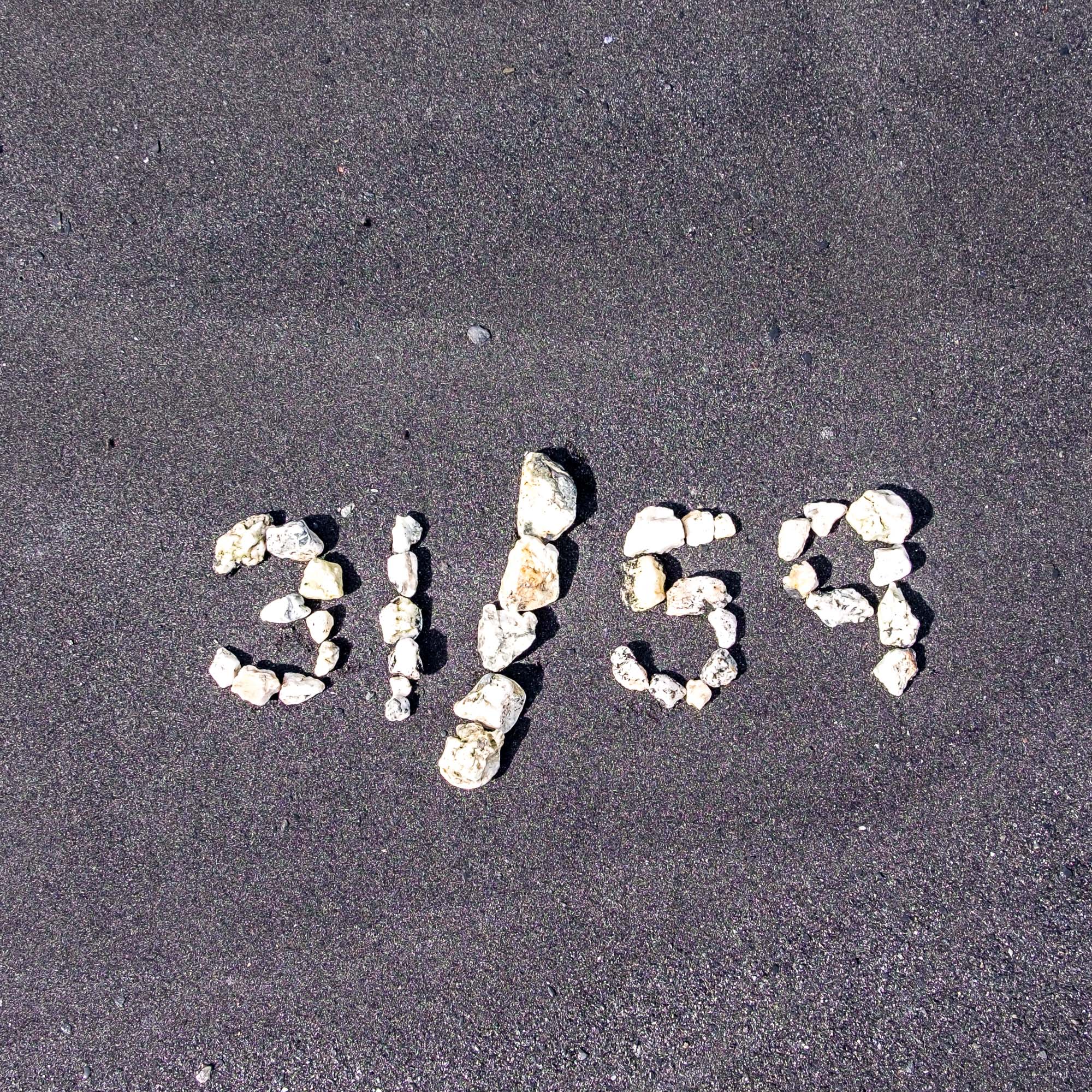Kenai Fjords National Park, Alaska, USA | Park 31/59
“Kenai Fjords National Park was established to maintain unimpaired the scenic and environmental integrity of the Harding Icefield, its outflowing glaciers and coastal fjords and islands in their natural state; and to protect seals, sea lions, other marine mammals, and marine and other birds and to maintain their hauling and breeding areas in their natural state, free of human activity which is disruptive to their natural processes.”
Glaciers, Fjords, and Wildlife: 3 Adventures in Kenai Fjords National Park
Kayaking next to the Aialik Glacier in Aialik Bay, one of the most active glaciers in Kenai Fjords National Park.
An evening walk on the moraine at Bear Glacier, a prime spot for backcountry camping and adventure.
Harbor seals nestle atop a glacier in Bear Glacier during our paddling trip in Kenai Fjords National Park in 2016.
A lot of people ask us what has been our favorite park so far this year and that question is practically impossible to answer because each park is so special in its own way. Perhaps a better way to answer that question, or to even ask it of ourselves, is to tweak it a bit—"what park would you have wished you had more time to spend in and definitely want to go back to?" That seems more appropriate... Kenai Fjords National Park on the Kenai Peninsula in Alaska is definitely one of them.
This park and its surrounding area has some huge draws for the outdoor set—great camping, a cool local scene, and pristine Alaskan wilderness sprawling into the mountains and to the seas. These are just a few of the reasons people want to visit the Kenai Peninsula. The things that motivate us to return are the experiences had while there... once you experience the landscape, you will undoubtedly want to explore it more in a variety of different ways.
This article is a mashup of topics including where to land on the Kenai Peninsula, what to do while there, and the outfits that can help you fulfill your adventures—the last of which becomes immensely important when trying to make a park experience great in a region that is notoriously complicated to navigate, while keeping within a budget and timeframe that meets your needs. So with that, here it goes!
Where to land:
Seward, Alaska
The waterfront town of Seward is the jumping off point into Kenai Fjords National Park. It's a little bit like Hawai’i and Southern California combined in terms of its laid back attitude, but with snowcapped mountains and dramatic glaciers in the backdrop. Each night during the summer, fisherman arrive at the docks to pull in their daily catch and weigh it dockside for onlookers to gasp at outside of Chinook's Restaurant—the kind of place we longed for in Washington, DC but never really found—good food, great beer, cool atmosphere, interesting people, and a view of the people behind-the-scenes who makes it all happen. Outside on the docks, you can watch boats come and go while seals and sea otters frolic in the bay and bald eagles and gulls noisily glide overhead. Seriously, what's not to love? There is something awesome to see and do in every direction, and 600,000 acres of protected wilderness cradling it all. If we could figure out a seasonal lifestyle, Seward could be a summer-time contender.
The waterfront community of Seward, Alaska is your jumping off point into Kenai Fjords National Park.
Marine life in Resurrection Bay.
Waterfront Camping
There are six waterfront campgrounds operated by the City of Seward that provide some of the best RV camping we've experienced this year. Iditarod, Resurrection, Marathon, Harborside, Alice, and Williams Park are all in close proximity to jumping off points into the national park—some sites have hookups, some do not; all have great scenery. What makes a site great in our estimation (and as such, makes this camping great) is when it meets the following criteria: seclusion and space, easy access to dump/filling stations, sites that are level and spacious, inclusion of fire pits, and close proximity to iconic sites in the national parks. As we've learned in the last nine months of camping throughout America, that is actually a very tall order. However, this area on the Seward waterfront delivers and it makes us want to return with Wally the Airstream when we have more time to stay and play. Word of advice: book well in advance! We aren't the only ones who love this camping area.
Wildlife constantly frolics in the Seward marina; aside restaurants, the Kenai Fjords National Park Visitor Center, and waterfront campgrounds that deliver in the city of Seward.
Wally the Airstream found a perfect camping spot in one of Seward's awesome waterfront campgrounds, just a couple of minutes from the Liquid Adventures' office from where we would push off to explore the Kenai Peninsula.
What to do:
Explore the Kenai Fjords and surrounding areas
Whether you are intrigued by the fjords, icebergs, glaciers, mountains, or the sea—where you can see aquatic marine life, photograph delicate sea ice, strap on some crampons and hike across a glacier, run to the top of a mountain, or paddle among seals in protected lagoons—it’s all right there for the taking, all of that wild magnificence that is so distinct to Alaska, just a couple of hours driving from the capital city of Anchorage.
Backcountry camping and kayaking through icebergs
If you want to find yourself floating in a parallel universe, this is your jam. Next to the largest glacier in Kenai Fjords National Park is a protected lagoon where icebergs rise from the sea and seals float among them, in a thick fog of silence, with a wilderness backdrop of green velvet mountains that are reminiscent of dreams... this is Bear Glacier.
Our experience at Bear Glacier is hands down one of the most exceptional we’ve had this year. The landscape, wildlife spotting, camping, and guide expertise was simply above. The trip goes like this: travel with an experienced captain to bypass a difficult inlet current with a flat-bottom boat; set up camp on top of a moraine with the sea on one side and a protected lagoon in the other; push off to paddle among icebergs and seals basking comfortably and free of predators in the fresh water cove; let the rest fall in.
Paddling through icebergs is incredibly visceral, as all of your senses are effected—warmth of the sun matched by cooling wind off of millions of year old ice, the thunderous sound of glaciers calving into the still water and echoing throughout the area, a black bear peeking its head out of the dense alder brush, flatulent harbor seals barking from the distance... surreal.
Our guide was an experienced pro with a wilderness leadership degree (oh how we wish that was offered when we both matriculated!) and the other guests were matched up with us based on their experience and ability level. Call it profiling, maybe it is, but when you are thrust into the wilderness, you want to be with others who are at a similar skill-level for the sake of everyone's comfort. The result was bouts of hilarious conversation, challenging paddles, and wilderness friendships that we will cherish forever.
Bear Glacier, an offshoot of the Harding Icefield. It is the largest glacier in the park.
Stef paddles among icebergs in a protected lagoon off of Bear Glacier.
Our Mountain Hardwear Ghost Sky 3 tent set up for the night atop a moraine near Bear Glacier in the Kenai Fjords... it was a champion again, as it has been for the duration of this Great American Road Trip.
A rare pink sky explodes at night near Bear Glacier in the Kenai Fjords, just following dinner and a long day of paddling through icebergs. This entire experience was surreal, challenging, eye-opening, and totally awesome.
Paddle aside an actively calving glacier
Sitting at the head of Aialik Bay is a dramatic ice-face named Aialik, a very active tidewater glacier that is one of the great draws in the park. One of the best ways to see it away from the fray of the tour boat congestion is on a kayak. The experience of hearing a glacier pop, crack, and boom is unlike any other; especially when the falling ice causes ripples in the water beneath your self-propelled sea vessel several minutes later. To get there, we arranged an all-day adventure (7:00am to 6:00pm) that started with a 2-hour scenic boat ride scouring the icy seas in search of marine wildlife that the area is known for, including Orca and Humpback whales, harbor seals; and black bear on the coastal shores. After landing in a small bay, we pushed off on kayaks to explore the Aialik Bay. While there are plenty of cool creatures and geologic features to see, the star of the show on this trip is the dynamic Aialik Glacier, calving before your eyes. This full day excursion packs in some of the best that the park has to offer, returning you to Seward in time for sunset.
One of the coolest things to see near the Aialik Glacier is the perspective of size and scale that a large tour ship lends as it glides right aside the massive ice face.
Heading toward the Aialik Glacier on a memorable day paddle that brought us near wildlife, geological formations, and to an active glacier that took our breath away each time it loudly dropped a piece of ice into the bay.
Heli flight to glacier hiking
This adventure took us outside of the technical boundary of Kenai Fjords National Park, but all of Alaska aside of Anchorage should be called a national park, so it joins the party! Here, we lifted off in a helicopter from the local airport in Seward and soared above Resurrection Bay and rugged mountains on a scenic heli-flight to the Godwin glacier, where we would strap on some crampons and take our inaugural glacier hike of the Greatest American Road Trip. Our guide stomped with us across the immense alpine icefield, pointing out moulins and crevasses, all the while feeding our curious minds with information about the history of mountaineering—an activity quite beloved to Alaska's adventure elite. If you want to pack a lot of adventure into one day, this trip will do it.
Stef forges atop the Godwin Glacier, emphatically avoiding moulins and crevasses, while gaining some knowledge that would turn out to become important in future glacier exploration...
Jon straddles a crevasse on the Godwin Glacier near Kenai Fjords National Park in Alaska.
Who to call, our guides in Kenai Fjords
Libby, our expert route finder and wilderness wizard in Bear Glacier, from Liquid Adventures. This is one seasoned guide--special hats off to her for her knowledge and passion for the Kenai wilderness and the rest of the world!
Josh, our "I'll teach you about geology, marine biology, and also glaciers" guide, in Aialik Bay.
Gaby, our "Want to know about glaciers and mountaineering? I've got you!" guide in Godwin Glacier.
There is enough sunshine inside the bayside office at Liquid Adventures that it could light up all of Alaska during even the coldest of winter months. The staff and ownership is passionate and knowledgable about the area, and they truly want to be there and it shows. The company rule is that all guides must have at least three years of experience to lead trips—and when you (as a guest) are in a place that is as wild and crazy as Alaska is, the feeling of safety while in the backcountry is extremely important. The owners are young and completely hands on, guiding many of the trips themselves and welcoming back seasonal staffers year after year. The guides whom we traveled with, time after time, touted how exceptional the owners are, and without any prodding. With such a broad collective of positive mojo, it's difficult not to feel great when heading out on an adventure—and that is before the spectacular Alaskan wilderness even shows itself.
Liquid Adventures' sister company, Exit Glacier Guides, are the mountain-based operation to the Liquid operation—the pioneers of glacier guiding on the Kenai Peninsula. All of the glacier guides are Wilderness First Responders, and extensively trained in glacier-specific scenarios. L
iquid Adventures and Exit Glacier Guides know this area better than anyone and provide outdoor experiences that are customizable and scalable to meet your budget requirements. Just tell them what you are looking to spend, and they will get you out there to experience Kenai Fjords in a wonderful way. We will without a doubt travel with them the next time we are in Kenai!
Quotable Images
Fact Box
601,839 acres | Alaska's smallest national park | Home to The Harding Icefield, the largest icefield in the United States
Official name: Kenai Fjords National Park
Date established: December 2, 1980
Location: Southeast Alaska, near Seward
How to get there: Drive 125-miles on the Old Seward Highway from Anchorage to the seaside town of Seward, where the National Park Visitor Center is located. Stop there to pick up info on how to get into the national park and where to go in the nearby vicinity.
How the park got its name: The naming of this park is a two-parter: “Kenai” describes its physical location, on the Kenai Peninsula. The origin of the word Kenai is unclear. According to the National Park Service, it could be a translation between the Athabaskan and Russian languages meaning “big flat”; or a Russian word for the Cook Inlet; or an Inuit translation for “black bear.” The name “Kenai Fjords” was suggested by Bailey Breedlove, a member of the National Park Service, who flew above the area in 1967 and thought it to be reminiscent of the fjords in Norway, where he served during WWII.
Iconic site in the park: The Harding Ice Field is the largest icefield in the United States, and the largest feature in the park, though it is not its massive size that makes it iconic. A relic of the Ice Age, it is the source of 40 glacier offshoots that have helped to carve the fjords that give this park its name and also its rugged coastline where scores of wildlife species thrive. The mile-high glacier, located in the Kenai-Chugach mountain range on the Kenai Peninsula, covers 700-square miles (about the size of Crater Lake) and is one of only four ice fields in the U.S. It is the only icefield located entirely on American soil.
Accessible adventure: Hopping on a day-long boat tour in coastal Alaska is often going to be the best "accessible adventure"—they operate regularly during high season and are typically affordable, they bring guests to the seas where sightings of marine and terrestrial wildlife can be made from a safe distance, and offer stunning views of glaciers and mountains the entire way. To get the most of your trip, learn as much as you can along the way... Kenai Fjords National Park Service Rangers narrate boat excursions operated by Major Marine Tours, pushing off right from the Seward waterfront. For 25 years they have shared the wonder of marine wildlife with guests, including stellar sea lions, sea otters, porpoises, orca and humpback whales, grey whales, bald eagles, puffins, and plenty of other creatures. In 2015, they showed President Barack Obama on a wildlife cruise around the fjords. If it's good enough for POTUS...
Walking away from our backcountry adventures with great memories and new friends -- captured with Fujifilm Instax after the conclusion of our trip. (Photo credit: Ruk DeSilva)
Big adventure: Backcountry camping on a moraine and paddling through icebergs at Bear Glacier is one of the most memorable experiences one can have in this park—its like exploring a parallel universe. To get to the lagoon where the icebergs live is an adventure in and of itself, as you must first bypass a wild current in shallow waters into the protected area. The experienced team of boat captains with Liquid Adventures have mastered this maneuver on a specially designed flat-bottom watercraft, and as a result, they are the only outfit currently offering this experience. Once you are there you will set up camp on a rocky moraine, and set out on paddle (kayak or stand up paddleboard) through icebergs that have broken off from the largest glacier in the park, Bear Glacier. Among the protected area, curious harbor seals may surround your boat, and if you are lucky, you will be socked in by a milky fog that makes this an even more enchanted and etherial experience.
Big adventure on a budget: Hike the strenuous Harding Ice Field Trail—an 8.2 mile path traversing cottonwood and alder forests, meadows, and the icefield itself, while gaining 1,000 feet of elevation with every mile. If you want to take a less aggressive approach but still want to have your hand at glacier exploration, make way to the Exit Glacier area of the icefield—the most popular site in the park—where you can explore a network of smaller trails. Exit Glacier Road is the only road that brings you into the national park, otherwise it is reachable only one foot or by boat.
Did you know…
Kenai National Park is the smallest national park in Alaska; and larger than 42 of the 59 national park in the entire National Park System. It's a big world up there in Alaska!
With the nearby town of Seward being accessible by train, boat, car, bus or float plane, the area around Kenai Fjords National Park is one of the most accessible in Alaska. Exit Glacier Road provides the only access into the national park that is reachable by car.
Flightseeing is a very popular way to explore this area, and it is rad! This is our ride with Exit Glacier Guides to the Godwin Glacier.
There are tons of ways to enjoy Kenai Fjords National Park ranging all experience and fitness levels – this is one of those places where there is truly something for everyone. Fishing, boating, paddling, camping, beach combing, hiking, touring by boat, flightseeing, glacier hiking, ice climbing, cross-country skiing, snowmobiling – if you can dream it, you can probably do it in the Kenai Fjords.
The park is broken down into three major features: Exit Glacier, Harding Icefield, and the coastal areas.
51% of Kenai Fjords National Park is covered by glacial ice.
Just like Glacier Bay, Kenai Fjords National Park is a living laboratory, and a goldmine of research opportunities for scientists and researchers from across the U.S. and the world who travel to the park to study flora, fauna, geologic processes, and weather—surveying survival, failures, and overall change. To read more about the research work at Kenai Fjords, check out “Field Notes.” Science is cool!
The Harding Ice Field, the most iconic site in the park, was named after President Warren G. Harding, who was the first President to visit the state of Alaska. It is the only icefield located entirely on American soil. Between 1986 to 2000, the icefield and its glaciers lost 12 square miles of ice cover, about 1.7%.
A glacier crevasse is a deep crack (crevice is the same type of fracture but created in rock instead of glacier.) They are often filled in by snowdrifts and are huge—potentially fatal—hazards to mountaineers of all skill levels.
Another ice feature you will find on a glacier is called a moulin, a surface opening to a deep well-like shaft that funnels into the plumbing system of a glacier. These are considered the glacial feature most lethal to human explorers, as once you fall in, you will almost certainly be swept away into the system never to be found...not to scare anybody, but glaciers are serious natural beasts.
Just like Glacier Bay, Kenai Fjords National Park is a living laboratory, and a goldmine of research opportunities for scientists and researchers from across the U.S. and the world who travel to the park to study flora, fauna, geologic processes, and weather—surveying survival, failures, and overall change. To read more about the research work at Kenai Fjords, check out “Field Notes.” Science is cool!
In 1968 a party of seven made the first documented traverse of the Harding Icefield. Traveling west to east on skis and snowshoes, the party made the crossing in seven days, completing their traverse at the appropriately named, Exit Glacier.
NPS / Dave Spencer
For those of you who love equations: Glacier ice feeding the fjord landscape flows at nearly 2-feet, or 20” per day; Exit Glacier ice must travel 3.5 miles to reach the water—some quick math tells us that it takes about 30 years for the ice to complete its path out to sea.
A black bear peeks his head out at Bear Glacier.
The dense vegetation that cradles the Harding Icefield and surrounding areas is just to a black bears' liking: rich with salmonberries. A good rule of thumb to practice in bear country is to always make sound when you are hiking/walking/existing; and to be extra cautious around sows (adult females) and cubs. (Stay tuned for our next park update where we will dive deep into the atmosphere of bear country!)
You will most likely see puffins when exploring this park during high season (late spring and summer.) A group of puffins is called a “circus.”
A rare orca whale sighting wields no drama, just astonishment.
Whale watching is incredibly popular in Glacier Bay and in Kenai Fjords National Parks, but it doesn’t always come easy. "Whale watching is sometimes whale waiting," says one Alaska boat captain.
Land-based wildlife in the park includes black and brown bear, coyote, mountain goat, river otter, moose, gray wolf and wolverine.
America's national bird and national animal, the Bald Eagle, is just one species of 191 that birders will mark off their list while visiting this national park.
For our birder friends, there are 191 recorded bird species in the park.
There are very few reptiles in Alaska due to the extreme cold winter weather. There is only one creature on Earth known to habituate on glacier ice, the ice worm, which relies on a steady temperature of 32 degrees—any colder, they freeze; and warmer, they disintegrate.
Bananas are considered by boat captains to be bad luck on sea vessels. Legend goes that bananas used to make all of the food it came in contact with spoil more quickly—perhaps caused by nitrates—and this long held belief lives on. Captains truly don't want you to bring bananas onboard, they may even chuck yours overboard. Some vessels have "no banana" signs; our boat captains took softer approaches, asking us as we entered “do you have any bananas with you?”
There are places people save up their cash to visit for measures of time to visit and this area is one of them—Alaska is indeed expensive. The reason for this is that resources are vital and inventory is low as supplies must be shipped in by barge or overland on semi trucks, regardless of the wild northern weather. Often times when supplies run out, that’s just how it is, and then, the price jacks up.
Two public use cabins, Aialik and Holgate, are available on the Kenai Fjords coast during the summer months and can be reached by boat or float plane. This is a super cool way to experience the national park!
Kenai Fjords is one of the only national parks that allows open carry and subsistence hunting and fishing.
In the nearby town of Kenai, “dip netting” is open to all residents for two weeks only during August. Locals can come pull up 25 fish a day from the mouth of the Kenai River to feed themselves and their families.
The Exxon Valdez oil spill in Prince William Sound in 1989 greatly contaminated the coastal area of the national parkland; which the National Park Service worked diligently to clean up in the following years.
The Mount Marathon Race in Seward was first ran in 1915 and is one of the oldest known footraces. It is notoriously brutal, climbing 2,900 feet in just over three miles. The trail is visible aside Mount Marathon from the low decks of Seward.
Random T-shirt quote seen in Seward: "The bear and lion may be stronger but the wolf doesn't perform in the circus."
Black and white treatment of a glacier in Kenai Fjords National Park.
“When I was 23, I went to Alaska by myself into the glaciers of the coast range and climbed a mountain by myself. It was incredibly reckless, incredibly stupid. But I was lucky. And I survived, and I came back to tell my story.
”









